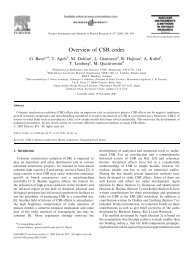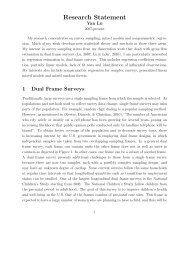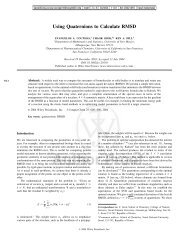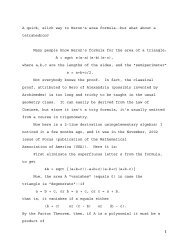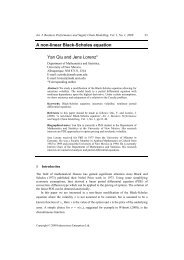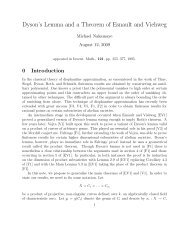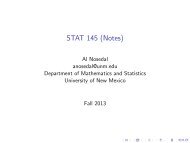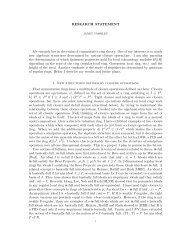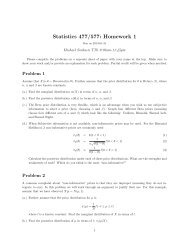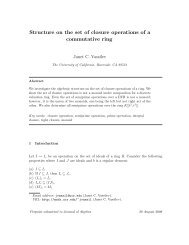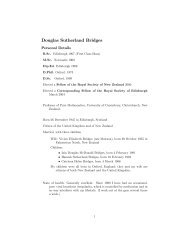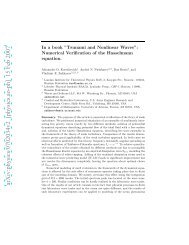OEO Office of Equal Opportunity - Department of Mathematics and ...
OEO Office of Equal Opportunity - Department of Mathematics and ...
OEO Office of Equal Opportunity - Department of Mathematics and ...
You also want an ePaper? Increase the reach of your titles
YUMPU automatically turns print PDFs into web optimized ePapers that Google loves.
222 ARTS AND SCIENCES<br />
IX. Women <strong>and</strong> Gender<br />
300./500. Studies in History. (1-3, no limit) ∆<br />
Will vary from instructor to instructor, but will be an in-depth<br />
analysis <strong>of</strong> specific historical problems. For course content,<br />
consult Schedule <strong>of</strong> Classes.<br />
320./520. History <strong>of</strong> Women from Ancient Times to the<br />
Enlightenment. (3) Slaughter<br />
(Also <strong>of</strong>fered as WMST 320.) Study <strong>of</strong> sex roles in primitive<br />
societies, classical views <strong>of</strong> women, the Judeo-Christian<br />
treatment <strong>of</strong> women, medieval social roles <strong>and</strong> the changes<br />
that came with the Renaissance <strong>and</strong> Reformation. Attention<br />
will be paid to the role <strong>of</strong> women in the family <strong>and</strong> to their<br />
economic function as well as to the less common activities <strong>of</strong><br />
saint, witch <strong>and</strong> revolutionary.<br />
321./521. Women in the Modern World. (3) Hutchison,<br />
Scharff, Slaughter<br />
(Also <strong>of</strong>fered as WMST 316.) Study <strong>of</strong> western women<br />
from pre-industrial to contemporary society which will focus<br />
on Victorianism, familial roles, changes in work patterns,<br />
feminist movements <strong>and</strong> female participation in fascist <strong>and</strong><br />
revolutionary politics.<br />
322./522. History <strong>of</strong> the Women’s Rights Movement. (3)<br />
Hutchison, Slaughter<br />
(Also <strong>of</strong>fered as WMST 330.) A detailed study <strong>of</strong> the movements<br />
for women’s rights in the U.S., Europe <strong>and</strong> Latin<br />
America in the 19th <strong>and</strong> 20th centuries. The topic’s approach<br />
will emphasize the movement’s relation to <strong>and</strong> impact on<br />
broader historical questions.<br />
344./544. U.S. Women to 1865. (3) Scharff<br />
This course introduces students to the history <strong>of</strong> American<br />
women’s roles, status <strong>and</strong> ideas before 1865.<br />
345./545. U.S. Women since 1865. (3) Scharff<br />
This course introduces students to the history <strong>of</strong> American<br />
women’s roles, status <strong>and</strong> ideas since 1865.<br />
427./627. History <strong>of</strong> Sexuality. (3) Slaughter<br />
(Also <strong>of</strong>fered as WMST 427.) Study <strong>of</strong> sexual behavior,<br />
politics <strong>and</strong> ideology in Western Society from the pre-modern<br />
world to the contemporary era. Background in History <strong>of</strong><br />
Women Studies is suggested.<br />
428./628. Women, War <strong>and</strong> Revolution. (3) Slaughter<br />
(Also <strong>of</strong>fered as WMST 428.) Study <strong>of</strong> women’s participation<br />
in wars <strong>and</strong> revolutions, <strong>and</strong> discussion <strong>of</strong> the social impact <strong>of</strong><br />
these events which <strong>of</strong>ten alters women’s status, experience<br />
<strong>and</strong> expectations. Typical approach using global example<br />
<strong>and</strong> case studies.<br />
453. Asian Studies Thesis. (3)<br />
(Also <strong>of</strong>fered as COMP, PHIL, POLS, RELG, 453.) Supervised<br />
research in one or more disciplines leading to an undergraduate<br />
thesis for the major in Asian Studies.<br />
462./608. Women in the U.S. West. (3) Scharff, Reyes<br />
History <strong>of</strong> women in the western United States from the<br />
colonial period to the present, with attention to women’s work<br />
<strong>and</strong> family roles, common stereotypes <strong>of</strong> western women,<br />
sex roles on the frontier <strong>and</strong> why women’s suffrage was first<br />
achieved in the West.<br />
471./651. Women in Early Latin America. (3)<br />
Gauderman, Hall<br />
(Also <strong>of</strong>fered as WMST 418.) A historical exploration <strong>of</strong> the<br />
place <strong>of</strong> women within the social systems <strong>of</strong> pre-Columbian<br />
<strong>and</strong> colonial Latin America. Will explore the gendered dimensions<br />
<strong>of</strong> the economy, politics <strong>and</strong> culture in indigenous <strong>and</strong><br />
Spanish societies.<br />
472./652. Women in Modern Latin America. (3) Bieber,<br />
Hall, Hutchison<br />
(Also <strong>of</strong>fered as WMST 472.) Course will focus on women<br />
in Latin America, 1821–present, through various historical<br />
developments. Will explore political themes, such as suffrage,<br />
revolution <strong>and</strong> military regimes <strong>and</strong> social dimensions<br />
<strong>of</strong> class, race, ethnicity, work <strong>and</strong> family.<br />
X. Race <strong>and</strong> Ethnicity<br />
300./500. Studies in History. (1-3, no limit) ∆<br />
Will vary from instructor to instructor, but will be an in-depth<br />
analysis <strong>of</strong> specific historical problems. For course content,<br />
consult Schedule <strong>of</strong> Classes.<br />
346./546. Native America to 1850. (3) Connell-Szasz<br />
(Also <strong>of</strong>fered as NAS 346.) This course will cover American<br />
Indian/Alaska Native history to 1850.<br />
347./547. Native America, 1850–1940. (3) Connell-Szasz<br />
(Also <strong>of</strong>fered as NAS 347.) The course will cover American<br />
Indian/Alaska Native history from 1850 to 1940.<br />
348./548. Native America Post-1940. (3) Connell-Szasz<br />
(Also <strong>of</strong>fered as NAS 342.) Course will address issues that<br />
Native Americans have dealt with from World War II to the<br />
early 21st century, including termination, urbanization, Red<br />
Power, gaming <strong>and</strong> self-determination.<br />
363./563. Early History <strong>of</strong> Mexican-Americans. (3) Reyes<br />
This course will review the history <strong>of</strong> the Southwest from<br />
pre-conquest <strong>and</strong> Spanish colonization to the U.S. invasion<br />
<strong>and</strong> its aftermath.<br />
364./564. Contemporary Chicana/o History. (3) Reyes<br />
This course examines the historical development <strong>of</strong> Chicana/<br />
o communities in the late 19th <strong>and</strong> 20th century with a special<br />
focus on the different socio-economic experiences <strong>of</strong> the<br />
Chicana/o population <strong>of</strong> the U.S.<br />
436./636. Race in 20th Century America. (3)<br />
The 20th century history <strong>of</strong> Americans’ struggle to solve “the<br />
problem <strong>of</strong> the color line.”<br />
444./612. Native American <strong>and</strong> Celtic History Since<br />
1700. (3) Connell-Szasz<br />
Course will have a cross-cultural focus <strong>and</strong> look at how major<br />
trends <strong>of</strong> the modern era have played out among various<br />
American Indian/Alaska Native Nations <strong>and</strong> the Celtic people<br />
<strong>of</strong> Eire (Irel<strong>and</strong>), Alba (Scotl<strong>and</strong>) <strong>and</strong> Cymru (Wales).<br />
463./643. Hispanic Frontiers in North America. (3)<br />
Reyes, Truett<br />
History <strong>of</strong> colonial encounters, Indian-European exchanges<br />
<strong>and</strong> conflicts, environmental transformations <strong>and</strong> changing<br />
identities at the northern frontiers <strong>of</strong> New Spain <strong>and</strong> Mexico.<br />
From the time <strong>of</strong> Columbus to 1848.<br />
464./644. U.S.–Mexico Borderl<strong>and</strong>s. (3) Truett<br />
History <strong>of</strong> the U.S.–Mexico borderl<strong>and</strong>s <strong>and</strong> its various<br />
native <strong>and</strong> immigrant communities from 1848 to the present.<br />
Focus on cultural <strong>and</strong> economic linkages, ethnic <strong>and</strong> military<br />
struggles, <strong>and</strong> formation <strong>of</strong> new identities on the border.<br />
465./645. History <strong>of</strong> Mexican Immigration. (3) Reyes<br />
This course examines the history <strong>of</strong> Mexican immigration to<br />
the U.S. We review historical interpretations <strong>of</strong> the broader<br />
political economy <strong>of</strong> colonial, 19th <strong>and</strong> 20th century America<br />
to contextualize past <strong>and</strong> current Mexican immigration.<br />
466./646. Native American Southwest. (3) Truett<br />
(Also <strong>of</strong>fered as NAS 466.) In this class we will explore the<br />
history <strong>of</strong> Native American groups <strong>and</strong> their relationships to<br />
dominant cultures <strong>and</strong> nations in the American Southwest<br />
<strong>and</strong> Northern Mexico.<br />
473./653. Indigenous Peoples <strong>of</strong> Latin America. (3)<br />
Bieber, Gauderman<br />
Historical overview <strong>of</strong> indigenous peoples <strong>of</strong> Spanish <strong>and</strong><br />
Portuguese America from pre-colonial times to the present.<br />
Emphasis on cultural history, contact <strong>and</strong> change <strong>and</strong> policies<br />
impacting native American Groups.<br />
UNM CATALOG 2006–2007 Symbols, page 611.



